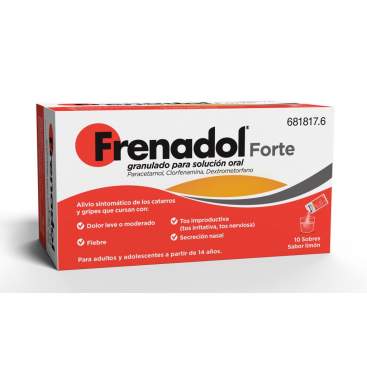Frenadol Forte 10 Sachets
Frenadol Forte 10 Sachets provides effective relief from cold and flu symptoms, including fever, pain, dry cough, and nasal congestion. Its formula combines paracetamol, chlorphenamine, and dextromethorphan for comprehensive care. Available at parafarmacia-online.com with fast and secure delivery.
Frenadol Forte 10 Sachets provides effective relief from cold and flu symptoms, including fever, pain, dry cough, and nasal congestion. Its formula combines paracetamol, chlorphenamine, and dextromethorphan for comprehensive care. Available at parafarmacia-online.com with fast and secure delivery.
Frenadol Forte 10 Sachets (English)
You can buy Frenadol Forte 10 Sachets online from UK, Austria, Belgium, Cyprus, Estonia, Finland, France, Germany, Greece, Ireland, Italy, Latvia, Lithuania, Luxembourg, Malta, the Netherlands, Portugal, Slovakia, Slovenia and Sweden.
Frenadol® Forte is an association of paracetamol, which reduces fever and relieves pain, chlorphenamine, which helps to reduce nasal secretion, and dextromethorphan, which has an antitussive action.
Symptoms That Relieve
This medicine is indicated to help adults and adolescents from the age of 14 to reduce the symptoms of colds and flu that cause mild or moderate headache, in addition to fever, unproductive cough (irritative and nervous), and nasal discharge.
What is Frenadol Forte and what is it used for?
Frenadol Forte 10 Sachets is a medication designed to relieve the symptoms of the common cold and flu, including fever, mild to moderate pain, dry cough, and nasal congestion. It combines three active ingredients for fast, effective relief:
- Paracetamol: Reduces fever and relieves pain.
- Chlorphenamine: Antihistamine that eases sneezing, runny nose, and watery eyes.
- Dextromethorphan: Suppresses dry cough by acting on the brain’s cough center.
This medicine is suitable for adults and adolescents aged 12 and older.
Frenadol Forte Composition
Each sachet contains:
- Paracetamol 650 mg
- Chlorphenamine Maleate 4 mg
- Dextromethorphan Hydrobromide 20 mg
- Excipients: Sucrose and Sunset Yellow FCF.
Important Note: Contains sucrose. Not suitable for patients with hereditary fructose intolerance or glucose-galactose malabsorption.
How to Take Frenadol Forte
- Adults and adolescents over 12 years: Dissolve one sachet in half a glass of warm water and take every 6–8 hours.
- Maximum dose: 6 sachets per day, with at least 6 hours between doses.
Special Recommendations:
- Take the last dose before bedtime to improve sleep.
- Discontinue use as symptoms improve.
Does Frenadol Forte Cause Drowsiness?
Yes, drowsiness is a common side effect due to chlorphenamine. Avoid driving or operating heavy machinery during treatment, and do not consume alcohol as it may enhance this effect.
Contraindications of Frenadol Forte
Do not use if:
- You are allergic to paracetamol, chlorphenamine, or dextromethorphan.
- You have severe liver disease, such as hepatitis or liver failure.
- You are taking MAO inhibitors or SSRIs.
- You are under 12 years of age.
Frenadol Forte vs Complex: Which to Choose?
- Frenadol Forte: Best for flu-like symptoms with dry cough.
- Frenadol Complex: Better for severe nasal congestion, as it contains pseudoephedrine.
Consult a pharmacist for personalized advice.
Frenadol Forte Side Effects
Common side effects include:
- Drowsiness, dry mouth, and nausea.
- Rare allergic reactions like rash or hives.
- Very rarely, liver or blood disorders.
Contact your doctor if severe side effects occur.
Where to Buy Frenadol Forte at the Best Price?
You can purchase Frenadol Forte 10 Sachets at parafarmacia-online.com, with these benefits:
- Competitive prices.
- Fast, discreet shipping.
- Expert pharmaceutical advice.
Frequently Asked Questions
Does Frenadol Forte cause drowsiness?
Yes, it can cause drowsiness. Avoid tasks requiring attention, such as driving, while taking this medication.
How to take Frenadol Forte?
Dissolve one sachet in warm water and take every 6–8 hours. Do not exceed six sachets per day.
Is Frenadol Forte safe during pregnancy?
It is not recommended during pregnancy or breastfeeding unless prescribed by a doctor.
Does Frenadol Forte help with cough?
Yes, it contains dextromethorphan, which effectively suppresses dry cough.
Andrés C. published the 09/10/2024 following an order made on 30/09/2024
Funciona.
Anonymous customer published the 21/02/2022 following an order made on 12/02/2022
mismo precios que en otras farmacias





